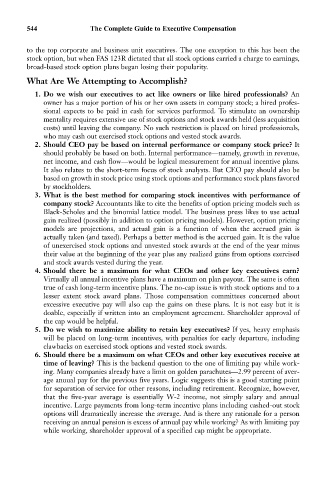Page 558 - Bruce Ellig - The Complete Guide to Executive Compensation (2007)
P. 558
544 The Complete Guide to Executive Compensation
to the top corporate and business unit executives. The one exception to this has been the
stock option, but when FAS 123R dictated that all stock options carried a charge to earnings,
broad-based stock option plans began losing their popularity.
What Are We Attempting to Accomplish?
1. Do we wish our executives to act like owners or like hired professionals? An
owner has a major portion of his or her own assets in company stock; a hired profes-
sional expects to be paid in cash for services performed. To stimulate an ownership
mentality requires extensive use of stock options and stock awards held (less acquisition
costs) until leaving the company. No such restriction is placed on hired professionals,
who may cash out exercised stock options and vested stock awards.
2. Should CEO pay be based on internal performance or company stock price? It
should probably be based on both. Internal performance—namely, growth in revenue,
net income, and cash flow—would be logical measurement for annual incentive plans.
It also relates to the short-term focus of stock analysts. But CEO pay should also be
based on growth in stock price using stock options and performance stock plans favored
by stockholders.
3. What is the best method for comparing stock incentives with performance of
company stock? Accountants like to cite the benefits of option pricing models such as
Black-Scholes and the binomial lattice model. The business press likes to use actual
gain realized (possibly in addition to option pricing models). However, option pricing
models are projections, and actual gain is a function of when the accrued gain is
actually taken (and taxed). Perhaps a better method is the accrued gain. It is the value
of unexercised stock options and unvested stock awards at the end of the year minus
their value at the beginning of the year plus any realized gains from options exercised
and stock awards vested during the year.
4. Should there be a maximum for what CEOs and other key executives earn?
Virtually all annual incentive plans have a maximum on plan payout. The same is often
true of cash long-term incentive plans. The no-cap issue is with stock options and to a
lesser extent stock award plans. Those compensation committees concerned about
excessive executive pay will also cap the gains on these plans. It is not easy but it is
doable, especially if written into an employment agreement. Shareholder approval of
the cap would be helpful.
5. Do we wish to maximize ability to retain key executives? If yes, heavy emphasis
will be placed on long-term incentives, with penalties for early departure, including
clawbacks on exercised stock options and vested stock awards.
6. Should there be a maximum on what CEOs and other key executives receive at
time of leaving? This is the backend question to the one of limiting pay while work-
ing. Many companies already have a limit on golden parachutes—2.99 percent of aver-
age anuual pay for the previous five years. Logic suggests this is a good starting point
for separation of service for other reasons, including retirement. Recognize, however,
that the five-year average is essentially W-2 income, not simply salary and annual
incentive. Large payments from long-term incentive plans including cashed-out stock
options will dramatically increase the average. And is there any rationale for a person
receiving an annual pension is excess of annual pay while working? As with limiting pay
while working, shareholder approval of a specified cap might be appropriate.

